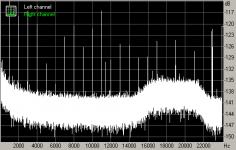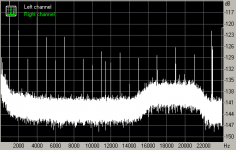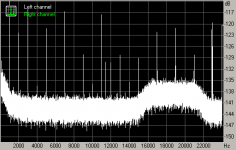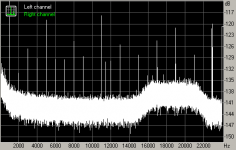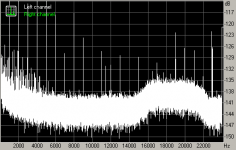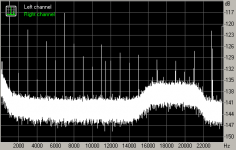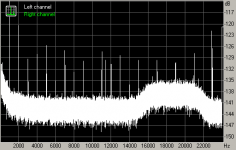Herb,
from the same post you quoted:
It has been stated in posts to this thread that the chips A'af is currently selling have the same date code as the chip shown in the very first post. This renders the date code pretty much useless when discussing the chips the that prompted this thread in the first place.
Paul
from the same post you quoted:
The date code on the top is identical on each chip,
It has been stated in posts to this thread that the chips A'af is currently selling have the same date code as the chip shown in the very first post. This renders the date code pretty much useless when discussing the chips the that prompted this thread in the first place.
Paul
To All,
Spencer, If you will please allow me at first to “summarize”, then we will surely agree thet changes & modifications can bring:
- Significant improvements
- Not a major improvement but still a welcome one
- An absolutely minor improvement
- 50:50 change when something becomes/sounds good, other worth
- Worth
- Terrible
- Catastrophe
Very embarrassingly, one can get some significant improvement for just very few $ - but also a true disaster for several hundreds/ thousands. Where to invest (Transport? Cable, DAC, etc), in what part (Mechanic? HF / ESL? Clock?) and how much (??), becomes very essential. WELL, AT LEAST THIS IS WHAT I THOUGHT UNTIL THIS THREAD.
What really bothers me now is the following topic:
One of the major diyaudio rules (may be even rule nr. 1) says: DON’T make too many changes at once, otherwise you are lost (we all know this).
But: This thread comes to a point where one COULD thing, that this is exactly our biggest mistake: One should NOT exchange parts one by one, as it leads to the WRONG conclusions and WAIST of money. Instead, one should follow simply the following:
1:
According to Herb (and George?) assumption, one should re-clock his DAC right, with the right layout and at the right place, and every PCM63 will sound basically OK, even a “P”. Even swapping should not be heard anymore. So save on the parts & experimenting.
2:
Or even better: Leave the PCM63: Bernhard is saying since long that a “P” can sound as good as “Y” but never as good as PCM56. In other words – instead of step by step, just go directly to the next level, for a good PCM56 and you will have a big part of the basic problem solved.
3:
Paul & Spencer: If the theoretical assumptions (in Post 262) are right, this means that one MUST NOT invest in the Transport, one MUST simply re-clock, to the highest degree of no Jitter, then one doesn’t need any expensive cable, just a cable.
4:
Spencer MUST not finish working on his Transport; instead he should through away the DIR 9001 (the one he is using) and Tent re-clock his equipment, etc.
OK, so let’s save money & time & aggravation. Here are my suggestion:
- Guido Tent & Bernhard will meet and find a way to produce a DAC based on PCM56.
- We will buy it, all of us, as a Group (reduced price)
- To easily finance this, we shell sell at first our cables (for down-payments) and our not-anymore-needed-once-heavily-modified Transports (later, for the Shipment costs, etc). A simple player would do the work.
I am completely open to more suggestions.
It is just that I don’t feel too relief yet.
Greetings.
Spencer, If you will please allow me at first to “summarize”, then we will surely agree thet changes & modifications can bring:
- Significant improvements
- Not a major improvement but still a welcome one
- An absolutely minor improvement
- 50:50 change when something becomes/sounds good, other worth
- Worth
- Terrible
- Catastrophe
Very embarrassingly, one can get some significant improvement for just very few $ - but also a true disaster for several hundreds/ thousands. Where to invest (Transport? Cable, DAC, etc), in what part (Mechanic? HF / ESL? Clock?) and how much (??), becomes very essential. WELL, AT LEAST THIS IS WHAT I THOUGHT UNTIL THIS THREAD.
What really bothers me now is the following topic:
One of the major diyaudio rules (may be even rule nr. 1) says: DON’T make too many changes at once, otherwise you are lost (we all know this).
But: This thread comes to a point where one COULD thing, that this is exactly our biggest mistake: One should NOT exchange parts one by one, as it leads to the WRONG conclusions and WAIST of money. Instead, one should follow simply the following:
1:
According to Herb (and George?) assumption, one should re-clock his DAC right, with the right layout and at the right place, and every PCM63 will sound basically OK, even a “P”. Even swapping should not be heard anymore. So save on the parts & experimenting.
2:
Or even better: Leave the PCM63: Bernhard is saying since long that a “P” can sound as good as “Y” but never as good as PCM56. In other words – instead of step by step, just go directly to the next level, for a good PCM56 and you will have a big part of the basic problem solved.
3:
Paul & Spencer: If the theoretical assumptions (in Post 262) are right, this means that one MUST NOT invest in the Transport, one MUST simply re-clock, to the highest degree of no Jitter, then one doesn’t need any expensive cable, just a cable.
4:
Spencer MUST not finish working on his Transport; instead he should through away the DIR 9001 (the one he is using) and Tent re-clock his equipment, etc.
OK, so let’s save money & time & aggravation. Here are my suggestion:
- Guido Tent & Bernhard will meet and find a way to produce a DAC based on PCM56.
- We will buy it, all of us, as a Group (reduced price)
- To easily finance this, we shell sell at first our cables (for down-payments) and our not-anymore-needed-once-heavily-modified Transports (later, for the Shipment costs, etc). A simple player would do the work.
I am completely open to more suggestions.
It is just that I don’t feel too relief yet.
Greetings.
As an exercise I've taken the files I made of a selection of PCM63P-Y chips and edited together slices of about 6 secs for 7 of the chips. I then applied a notch filter to remove the 997hz test tone, and applied 60dB gain to the file. Because the gain is quite high you can hear low level digital noise bursts from the recorder writing to compactflash. The distortion from the PCM63's will be steady noise. There are glitches were the files are edited together so it's pretty easy to hear where one chip finishes and the next starts.
These chips were tested under identical conditions. The only change was to power down the D1V3, swap the chip over and power up. Nothing was physically moved, and no settings were changed. The differences are ENTIRELY due to the difference between chips.
The first 5 chips are from the batch A'af sent last week, and last two from the first four I received.
I measured the worst of the first six harmonics for each chip and got the following:
1. 53.4 dB
2. 55.1 dB
3. 52.9 dB
4. 55.9 dB
5. 47.0 dB
6. 54.0 dB
7. 57.2 dB
the file is about 6.5mb:
http://www.mactrix.com.au/files/dac compare.wav
These chips were tested under identical conditions. The only change was to power down the D1V3, swap the chip over and power up. Nothing was physically moved, and no settings were changed. The differences are ENTIRELY due to the difference between chips.
The first 5 chips are from the batch A'af sent last week, and last two from the first four I received.
I measured the worst of the first six harmonics for each chip and got the following:
1. 53.4 dB
2. 55.1 dB
3. 52.9 dB
4. 55.9 dB
5. 47.0 dB
6. 54.0 dB
7. 57.2 dB
the file is about 6.5mb:
http://www.mactrix.com.au/files/dac compare.wav
spzzzzkt said:the file is about 6.5mb:
http://www.mactrix.com.au/files/dac compare.wav
Paul, I can't open the file. My Real Player refuses (?). Can you please double check?
can you download it? is it that realplayer won't open the file?
the file is 48khz/24bit and i don't really want to resample or dither.
be warned the file isn't really very much fun to listen to
edit: according to this page realplayer won't play 24bit files. You'll need to use something else to play the file.
the file is 48khz/24bit and i don't really want to resample or dither.
be warned the file isn't really very much fun to listen to
edit: according to this page realplayer won't play 24bit files. You'll need to use something else to play the file.
Gentlemen,
For all certainty.... RECLOCKING should be done by circuits which should be connected BETWEEN the dig-filter and the DACs. In my posting 141 these circuits are U3 and U3a. (The digram of the rest of the circuit is in my posting 140.) U3 and U3a are controlled by a low-jitter-clock.
Just changing the clock does not satisfy.....
For all certainty.... RECLOCKING should be done by circuits which should be connected BETWEEN the dig-filter and the DACs. In my posting 141 these circuits are U3 and U3a. (The digram of the rest of the circuit is in my posting 140.) U3 and U3a are controlled by a low-jitter-clock.
Just changing the clock does not satisfy.....
Gentlemen,
For all certainty.... RECLOCKING should be done by circuits which should be connected BETWEEN the dig-filter and the DACs. In my posting 141 these circuits are U3 and U3a. (The digram of the rest of the circuit is in my posting 140.) U3 and U3a are controlled by a low-jitter-clock.
Just changing the clock does not satisfy.....
For all certainty.... RECLOCKING should be done by circuits which should be connected BETWEEN the dig-filter and the DACs. In my posting 141 these circuits are U3 and U3a. (The digram of the rest of the circuit is in my posting 140.) U3 and U3a are controlled by a low-jitter-clock.
Just changing the clock does not satisfy.....
Spencer, IY,
found some interesting comments on Transport jitter here:
http://members.chello.nl/~m.heijligers/DAChtml/jittermeas/jitter.html
the second to last conclusion is that:
found some interesting comments on Transport jitter here:
http://members.chello.nl/~m.heijligers/DAChtml/jittermeas/jitter.html
the second to last conclusion is that:
Cleaning up the conversion clock is necessary, to eliminate transport dependent effects during DA conversion.
Comments on Transport jitter
Paul,
I went through the all doc. As for the quotation - "Cleaning up the conversion clock is necessary, to eliminate transport dependent effects during DA conversion":
First of all, in both my Marantz Transports (CD-72SE and CD-10) the Quartz was renewed and stabilized, both mechanically and electrically.
But even if we will build a clock into the DAC (conversion), and even if we will Tent-Link it, I am confidence that there will always be some kind of influence on the signal coming from the transport mechanic / laser unit / diodes & the all other electronic, includes its PSU. I don't think this would be 100% over-bridge.
Sound-diferences between transporter however should become somehow smaller, like between K and Y, may be
Greetings
p.s. Had still problems with my Media Player encoding 24bit, sadly.
Paul,
I went through the all doc. As for the quotation - "Cleaning up the conversion clock is necessary, to eliminate transport dependent effects during DA conversion":
First of all, in both my Marantz Transports (CD-72SE and CD-10) the Quartz was renewed and stabilized, both mechanically and electrically.
But even if we will build a clock into the DAC (conversion), and even if we will Tent-Link it, I am confidence that there will always be some kind of influence on the signal coming from the transport mechanic / laser unit / diodes & the all other electronic, includes its PSU. I don't think this would be 100% over-bridge.
Sound-diferences between transporter however should become somehow smaller, like between K and Y, may be
Greetings
p.s. Had still problems with my Media Player encoding 24bit, sadly.
IY,
try using a copy of audacity.
http://audacity.sourceforge.net
those other factors will be minor at best.
the transport recovers bits from the disc and converts to a a digital signal transmitted by spdif. If you are relying on recovered clock, any degradation of the transmitted signal will increase the level of jitter recovered by the receiver chip which is then passed on to digital filter and to the dac chips. So if you are relying on recovered clock changes to the transport and cable which give a cleaner digital signal, and result in reduced jitter in the recovered clock will be audible.
If the dac uses a secondary PLL to generate a low jitter clock, the influence of the recovered clock is significantly reduced. I wouldn't suggest that the transport has no effect, but it will be far less significant.
cheers
Paul
try using a copy of audacity.
http://audacity.sourceforge.net
those other factors will be minor at best.
the transport recovers bits from the disc and converts to a a digital signal transmitted by spdif. If you are relying on recovered clock, any degradation of the transmitted signal will increase the level of jitter recovered by the receiver chip which is then passed on to digital filter and to the dac chips. So if you are relying on recovered clock changes to the transport and cable which give a cleaner digital signal, and result in reduced jitter in the recovered clock will be audible.
If the dac uses a secondary PLL to generate a low jitter clock, the influence of the recovered clock is significantly reduced. I wouldn't suggest that the transport has no effect, but it will be far less significant.
cheers
Paul
I should add that those comments regarding reducing transport dependence come from the team that designed the precursor of the Tent DAC. The reclocking circuit Herb posted is almost identical - only resistor values are different - to the circuit in their DIY dac.
http://members.chello.nl/~m.heijligers/DAChtml/dig_r2b.pdf
http://members.chello.nl/~m.heijligers/DAChtml/us.htm
http://members.chello.nl/~m.heijligers/DAChtml/dactop.htm
http://members.chello.nl/~m.heijligers/DAChtml/dig_r2b.pdf
http://members.chello.nl/~m.heijligers/DAChtml/us.htm
http://members.chello.nl/~m.heijligers/DAChtml/dactop.htm
- Status
- This old topic is closed. If you want to reopen this topic, contact a moderator using the "Report Post" button.
- Home
- Source & Line
- Digital Line Level
- Real or fake PCM63?
